Growing parsley seedlings
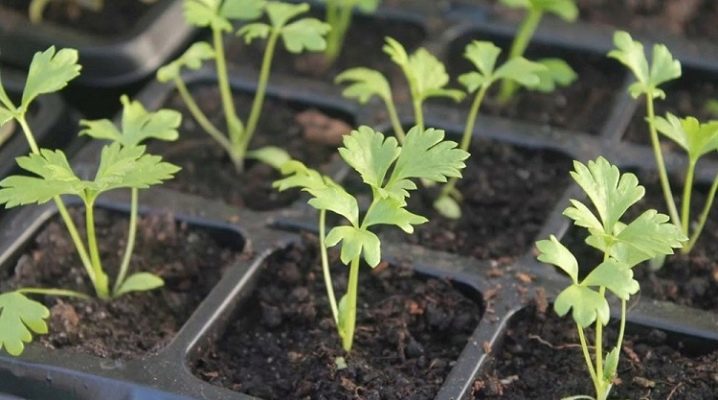
Most gardeners grow parsley directly from seed outdoors. However, with the help of seedlings, you can get the earliest delicious greens full of vitamins. Let's get acquainted with the features of this technique in more detail.
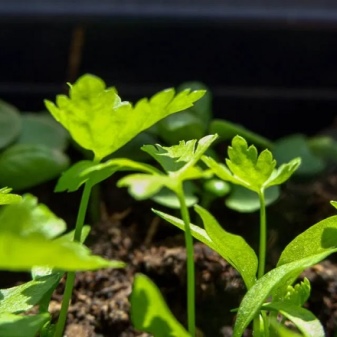

Peculiarities
Growing parsley for seedlings is far from a new agricultural technology. It allows you to get greens much earlier - about 60 days before the specimens from seeds are ready. Seedlings can be grown using two techniques.
- The seeds are grown in fertile soil in containers, and then they are transplanted together with the soil. Such parsley is completely stress-free.
- Seedlings are grown in small pots, and then moved to an area with open roots... This method will require adaptation from plants.
Growing greens with seedlings has the following advantages:
- you can enjoy fresh herbs much earlier;
- parsley is tastier, its amount will be large;
- the landing area of the site is saved;
- much less seed is consumed;
- you can grow capricious varieties with low winter hardiness;
- there is no need to thin out the plantings.
There are also disadvantages:
- it will be necessary to build and equip greenhouses;
- growing by the seedling method will take a lot of time and effort;
- when planted with an open root system, there is a high probability that the root can be damaged.
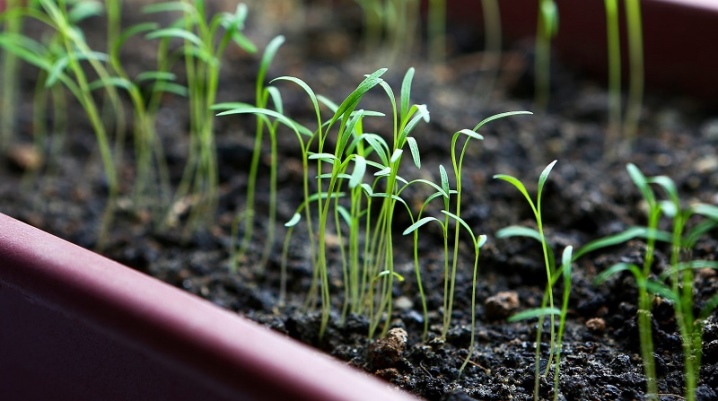
Suitable varieties
If you nevertheless decide to try growing parsley seedlings, you need to find out in advance which varieties are suitable for this. So, it has already been mentioned that an open root system can be damaged during planting. Such parsley either takes root hard or dies. Therefore, in general, it is better to abandon root varieties altogether. They are generally planted before winter. But leafy ones will be a good choice. Let's consider a few of the most suitable ones.
- "Aster". It is a curly-leaved variety of greenery. In two months the plant is fully ripe. If the greens are cut, they begin to recover again.
- "Plain sheet"... An excellent choice for any gardener, because this parsley gives excellent yields and has a bright aroma. It takes about 70 days to ripen the variety.
- "Breeze"... The disadvantage of this variety is the long ripening period (2.5 months). However, such parsley turns out to be very large, it lies well at home.
- Esmeralda... Curly-leaved thick parsley. Recovers perfectly after cutting greens.
- "Bogatyr"... This subspecies matures for a long time - up to 140 days. However, it can be grown even in the shade. Parsley produces abundant greens.
In addition to the varieties described, you can also choose:
- "Bravo";
- "Sandwich";
- "Curly".
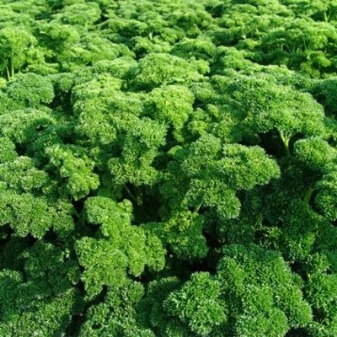
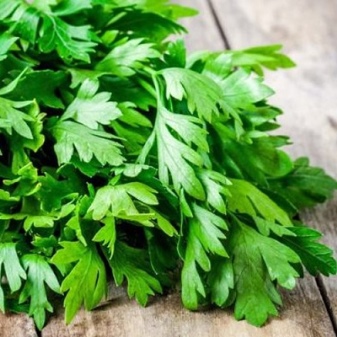
Sowing preparation
Choosing a good variety of parsley is only half the battle... You also need to properly prepare seeds, containers, soil. Experienced gardeners know that seed contains essential oils that can inhibit seedling. Such oils should be removed before planting. To do this, the grains are soaked in water for three days. The liquid should be warm. It is completely replaced once a day. If any seeds have surfaced, they are discarded. The rest are carefully dried, wrapped in paper and placed in the refrigerator for a week. If the seed was purchased from a good store, it will not need any additional processing.However, it is better to process your own grains with a weak solution of manganese.
Simultaneously with the seeds, containers are also prepared. It is best if they are plastic or wooden boxes. The container must be large. It is preliminarily disinfected. For example, you can rinse in boiling water and then treat with an antiseptic. There should be drainage holes at the bottom of the boxes. It is also important to choose the right soil. The best option is to buy a ready-made seedling substrate. However, you can take land from your own garden. It will either need to be calcined or frozen. It is recommended to do this in a couple of weeks so that the soil can restore its useful qualities. Many gardeners take half of their soil and half of the purchased soil, mix them.
You can also add a little sand to such a substrate to loosen the soil. If the soil is acidic, the acidity must be lowered with chalk or dolomite flour.
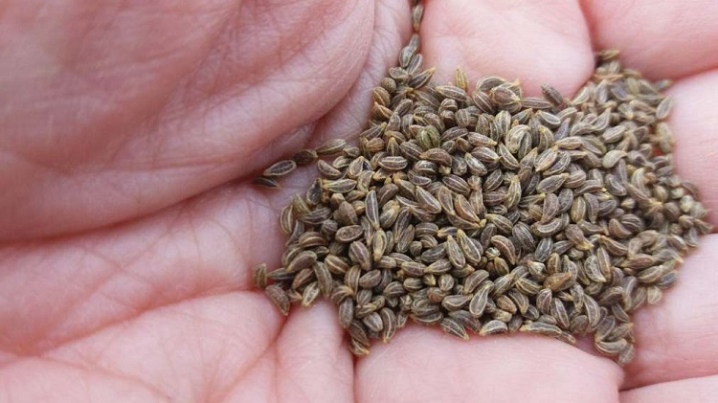
Sowing work
Once everything is ready for use, the seeds can be sown in a container. At home, this procedure is recommended to be carried out in March. Thus, in May, you can already plant the plants in open soil. However, when breeding parsley with seedlings, it is necessary to take into account the climate of your own region. If it is cold, then the planting time can be slightly shifted.
Now let's look at the seed planting algorithm itself:
- drainage is organized at the bottom of the selected container;
- fill the containers with soil;
- moisturize the substrate;
- grooves are made in it with a depth of 1 centimeter;
- grains are placed there, keeping a distance of 2 cm between them;
- sprinkle the sown material with a thin layer of substrate;
- sprinkle everything from a spray bottle;
- cover the container with glass or any other transparent material;
- take out boxes on warm and well-lit windowsills.
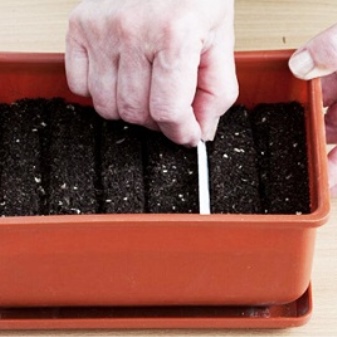

Growing seedlings
Parsley planted at home will have to be carefully looked after. Cultivation consists of several important points.
- The right environment. Seedling containers should be well lit. If there is not enough natural light, it is better to buy bioluminescence immediately. The room temperature should be between 18 and 20 degrees Celsius.
- Airing... If the shelter is not removed daily, then the seedlings will simply suffocate. Therefore, every day for 20 minutes glass or film must be removed.
- Watering... The substrate in the containers must always be moistened. Usually it should be watered every couple of days. For this, a spray bottle is used.
- Removing the shelter. The shelter is removed at the moment the first shoots appear. They look like small loops. The sprouts are very weak, so if you leave the cover they can start to turn yellow.
- Top dressing... You can feed young parsley with complex mineral mixtures. Such substances are sold in horticultural stores and are marked "For greenery." Top dressing is organized by irrigation, carried out every 10 days.
- Picking... It is carried out when the sprouts already have 3 full leaves. The purpose of the procedure is seedling thinning. The bushes are planted so that they have more space. The distance between the shoots is 20 millimeters.
- Hardening... Young shoots must sooner or later be taught to new conditions. For this, hardening is carried out. It is necessary to open a window in the room with containers and begin to ventilate. At first, a few minutes, but every day the time increases.
However, it is important that it is not too cold or windy outside. Saplings begin to harden 14 days before planting in a permanent place.
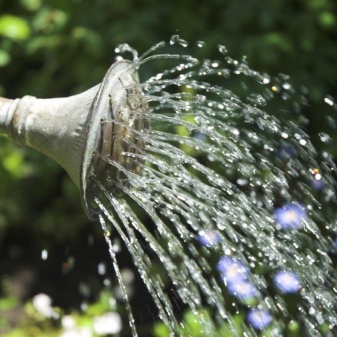

Landing in open ground
To grow healthy and lush greenery, sooner or later the seedlings will have to be moved outdoors. Seedling sprouts can be planted in May, but the soil should be warmed up to 10 degrees Celsius.. The soil for planting is prepared in the fall. The earth must be dug up, and the mullein must also be brought into it. In the spring, a few days before planting, the site is again dug up, mineral fertilizing is added there. The ground should be moist at the time of planting.
Planting activities are best done in the early morning or evening. In a few hours, containers with seedlings are watered to form a dense earthen lump. On the site, parsley is placed at a distance of 5-8 centimeters, but the distance between the rows should be 25 cm... The technology of planting greens depends on the capacity. The easiest way is to plant plants that are in peat cups. They are not taken out at all, but immediately immersed in the hole. Bushes are taken out of the common container with a spatula, carefully prying each copy with it. Plants must be planted together with an earthen clod.
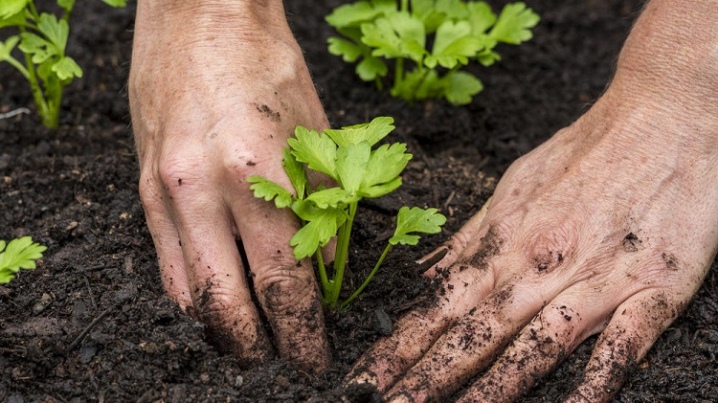
Follow-up care
Now all the most difficult is over, and all that remains is to properly grow the resulting seedlings. The first important point is proper watering. Any greenery loves water, then it turns out to be lush and juicy. It is necessary to water during the hours when there is no aggressive sun, that is, in the morning or in the evening. Water is taken only warm, settled. Watering frequency is 2-3 times a week. For irrigation, use a spray or garden watering can with fine holes. The hose is out of place here.
Important: if you want to prepare parsley for the winter, then watering must be stopped 14 days before harvest... This will make the greens more aromatic. Fertilization will also be required. The first time the sprouts are fertilized 4-5 days after planting, while taking ammonium nitrate. For 10 square meters, 50 grams of the substance should be enough. There should be several such dressings. Also do not forget to loosen the soil. This should be done every four days. When the greens are ready to be harvested, they must be carefully cut off.
It is important that after harvesting, 20-30 mm of shoots remain above the ground. Then they will sprout again.
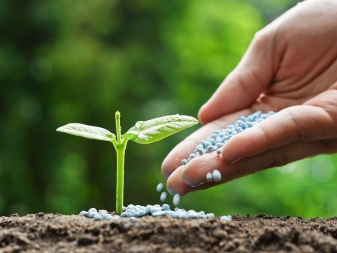
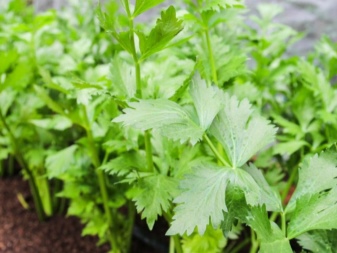










The comment was sent successfully.